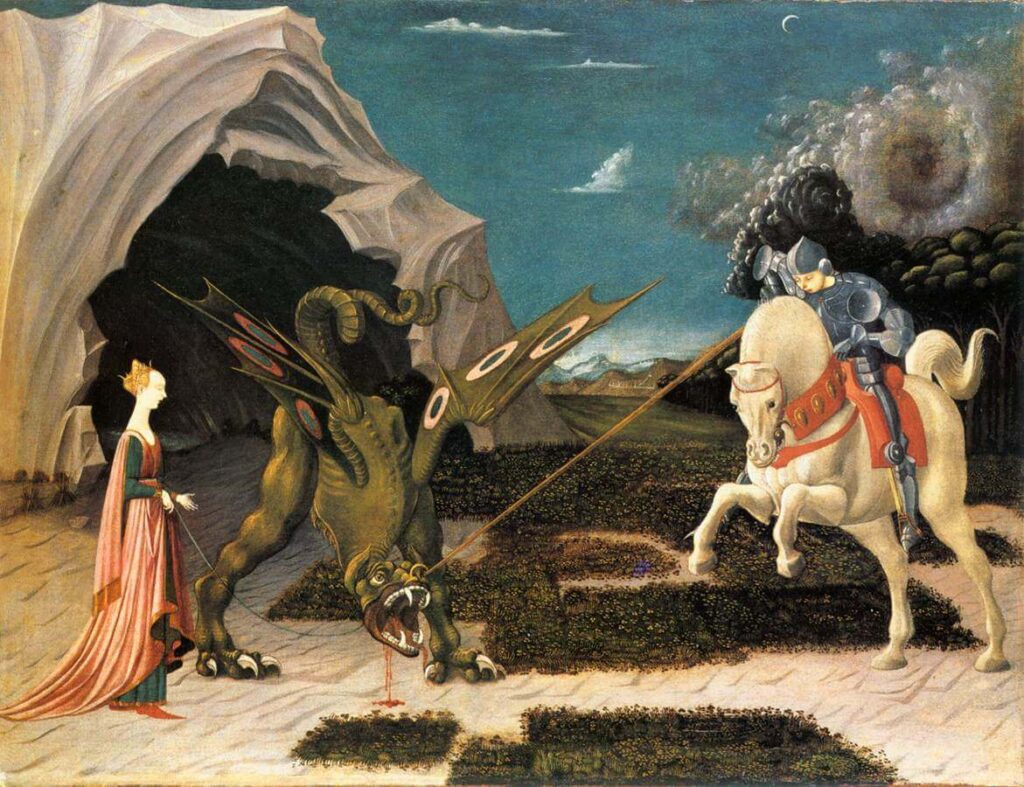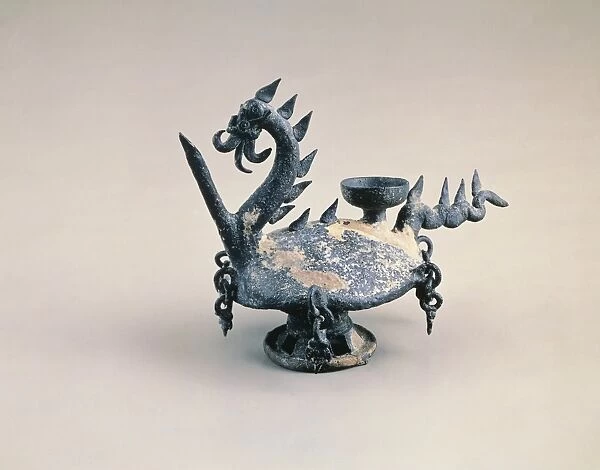By Daniel Benshana
Each issue, the Art Lantern invites a well-known, or not so well-known, art world personality to write a speakeasy essay on a topic of interest.
Daniel Benshana is a writer and son of the poet Shänne Sands. He lives and works in Cornwall and sometime s as a background artist on TV and films.
A Roman soldier of Christian faith, St. George saved the daughter of a Pagan king by subduing a dragon with his lance. Princess Sabra then led the dragon to the city where St. George killed it with his sword, prompting the king and his subjects to convert to Christianity. Likely, George wasn’t English, and he wasn’t a knight. He was a member of the Roman Army having been born in Turkey and dying in Syria Palestrina, the Roman province, and buried in Lod. He probably never visited England but became popular with Edward I (1272-1307). At least, unlike many saints, he probably existed and became popular in England from the ninth century. And since most of the stories we have were written centuries after he is supposed to have died ‘probably existed’ is the best we can suggest. We must remember the proclivity of the early church (and even the modern church) to delight in finding and making saints both to underpin the faith of Christians as a whole and to cement the faith in the definite existence of a god. If such as these died for their faith, then you can make it to church this Sunday. But it is a fact that from Armenia through Nubia to Rome, early Christians honoured him as a saint. And it is a fact that there is a myth about him and a day set aside for him.
Let’s be honest dragons as described in the legends do not exist. But in so far as the legend of St George goes back to the emperor Diocletian who persecuted and killed him for converting to Christianity, the symbol of the fearsome, fire-breathing enemy of princesses everywhere has its obvious forebears.

St George is such a symbol that his cross was the flag of England under Edward 1st and his red cross is still a part of the flag of the United Kingdom; such is the power of legend and tradition. The single knight who faced a fearsome dragon and almost lost but defeated it in the end by killing it, for a princess, no less and not, notice, by making friends with it like a decent Christian.

Paolo Ucello: St George and the Dragon (1470) Tempera
The Golden Legend by Jacobus de Voragine is the first written account of the legend which was by then (1269+) 900 hundred years old. This is a history of many of the saints on Christendom up to that point and obviously is a heavily embellished oral story. But myths have great power and today St George is not just the patron saint of England – he is particularly praised by Christian Arabs as his mother is supposed to have been born in Lydda, in Syria-Palestrina and has been held in esteem in Georgia (the country) since the 4th century and again his red cross is a part of their flag. In the Persian Book of Kings, Rustem kills the dragon in his second trial symbolizing the battle between Iran and Turania Here the horse helps the knight defeat the dragon, with the dragon contributing his lower nature to the horse’s physical energy.
Such heroes are a part of giving a tribe a common tradition which helps to unify the country and gives them something to shout about when they charge an enemy. Most mythical people like this – King Arthur for example – and known nation builders – Alexander the Great, Charlemagne, Chin – are all great warriors. Few nations laud pacifists. George also became a saint which means we have to see the miracles in his story not just the shining white horse, but also the wonder of an entire town becoming Christian when he saved them from the dragon. It is ridiculous anyone ever believed these stories, but then human beings love to believe the ridiculous.
St George’s dragon was a beast who needed sacrifice to placate his intent to destroy a town, but this is exactly what tribute was to the Athenians. The dragon is man as we experience him in every nation and the knight is the man we all want to be but never are. We invoke their name to give us a part of their courage – like kissing a medallion before a game or a battle. The symbol is of the lesser might defeating the greater might and saving the life of a woman – in this case a princess so in effect saving the future of the kingdom. It is how one man can make a difference through his faith, and in George’s case very good eyesight to see the dragon’s weak spot.
But myths are not guides to how the world is run, they are stories meant to blind us. None of us is George, we are each a scale on the dragon and the princess is our planet. We nearly always end up slaying the wrong animal or dragon, because the question – who is the human and who the beast – is not answered correctly. Why do we think errant knights were good people? Why was anyone ever clad in steel with weapons on him to kill? Because in real life the dragon, as I said at the start, never existed but these errant knights certainly did. They were the Christian war machine. And it is long past the time when we should stop lauding murderers or princesses.

